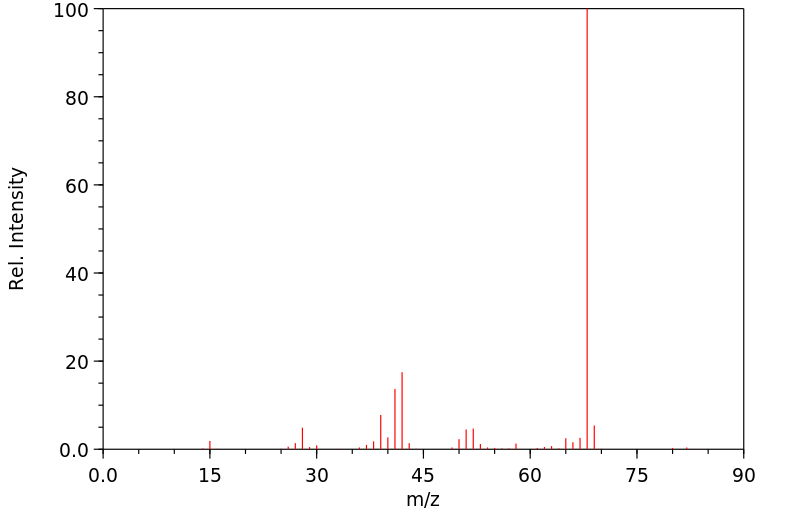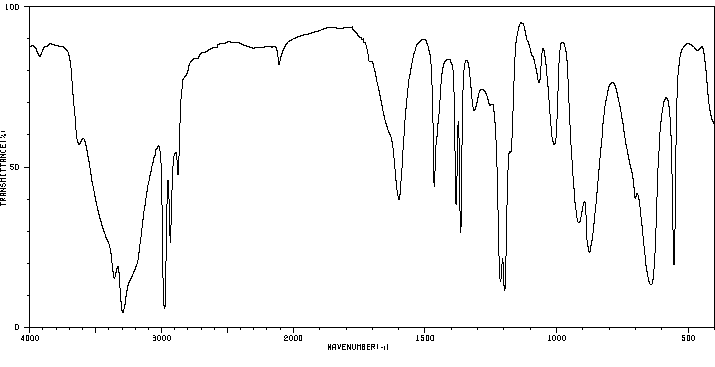2-甲基-3-丁炔-2-胺 | 2978-58-7
中文名称
2-甲基-3-丁炔-2-胺
中文别名
3-氨基-3-甲基-1-丁炔;1,1-二甲基炔丙基胺
英文名称
1,1-dimethylprop-3-ynylamine
英文别名
1,1-Dimethylpropargylamine;2-methylbut-3-yn-2-amine;2-methyl-3-butyn-2-amine;3-amino-3-methyl-1-butyne;3-Butyn-2-amine, 2-methyl-
CAS
2978-58-7
化学式
C5H9N
mdl
MFCD00008052
分子量
83.1332
InChiKey
VUGCBIWQHSRQBZ-UHFFFAOYSA-N
BEILSTEIN
——
EINECS
——
-
物化性质
-
计算性质
-
ADMET
-
安全信息
-
SDS
-
制备方法与用途
-
上下游信息
-
文献信息
-
表征谱图
-
同类化合物
-
相关功能分类
-
相关结构分类
物化性质
-
熔点:18°C
-
沸点:79-80 °C/760 mmHg
-
密度:0.79 g/mL at 25 °C
-
闪点:2 °C
-
LogP:0.26 at 23℃
计算性质
-
辛醇/水分配系数(LogP):0
-
重原子数:6
-
可旋转键数:1
-
环数:0.0
-
sp3杂化的碳原子比例:0.6
-
拓扑面积:26
-
氢给体数:1
-
氢受体数:1
安全信息
-
TSCA:Yes
-
危险等级:3.1
-
危险品标志:C
-
安全说明:S16,S26,S36/37/39,S45
-
危险类别码:R22,R34,R11
-
WGK Germany:3
-
海关编码:2921199090
-
危险品运输编号:UN 2733
-
RTECS号:ER9543533
-
包装等级:II
-
危险类别:3.1
-
危险标志:GHS02,GHS05,GHS07,GHS08
-
危险性描述:H225,H302,H314,H334
-
危险性防范说明:P210,P261,P280,P305 + P351 + P338,P310
-
储存条件:| 易燃区 |
SDS
| Name: | 1 1-Dimethylpropargylamine 90% ( remainder water) Material Safety Data Sheet |
| Synonym: | 1,1-Dimethyl-2-propynylamine |
| CAS: | 2978-58-7 |
Synonym:1,1-Dimethyl-2-propynylamine
Section 2 - COMPOSITION, INFORMATION ON INGREDIENTS
| CAS# | Chemical Name | content | EINECS# |
| 2978-58-7 | 1,1-Dimethylpropargylamine | 90 | 221-029-7 |
Risk Phrases: 11 34
Section 3 - HAZARDS IDENTIFICATION
EMERGENCY OVERVIEW
Highly flammable. Causes burns.
Potential Health Effects
Eye:
Causes eye burns.
Skin:
Causes skin burns.
Ingestion:
May cause severe and permanent damage to the digestive tract. Causes gastrointestinal tract burns.
Inhalation:
Causes chemical burns to the respiratory tract. Vapors may cause dizziness or suffocation.
Chronic:
Chronic exposure may cause effects similar to those of acute exposure.
Section 4 - FIRST AID MEASURES
Eyes: Flush eyes with plenty of water for at least 15 minutes, occasionally lifting the upper and lower eyelids. Get medical aid immediately. Do NOT allow victim to rub eyes or keep eyes closed.
Extensive irrigation with water is required (at least 30 minutes).
Skin:
Get medical aid. Immediately flush skin with plenty of water for at least 15 minutes while removing contaminated clothing and shoes.
Wash clothing before reuse. Discard contaminated clothing in a manner which limits further exposure. Destroy contaminated shoes.
Ingestion:
Do not induce vomiting. If victim is conscious and alert, give 2-4 cupfuls of milk or water. Never give anything by mouth to an unconscious person. Get medical aid immediately.
Inhalation:
Get medical aid immediately. Remove from exposure and move to fresh air immediately. If breathing is difficult, give oxygen. Do NOT use mouth-to-mouth resuscitation. If breathing has ceased apply artificial respiration using oxygen and a suitable mechanical device such as a bag and a mask.
Notes to Physician:
Section 5 - FIRE FIGHTING MEASURES
General Information:
As in any fire, wear a self-contained breathing apparatus in pressure-demand, MSHA/NIOSH (approved or equivalent), and full protective gear. Vapors may form an explosive mixture with air.
During a fire, irritating and highly toxic gases may be generated by thermal decomposition or combustion. Use water spray to keep fire-exposed containers cool. Containers may explode in the heat of a fire. Flammable liquid and vapor.
Extinguishing Media:
For small fires, use dry chemical, carbon dioxide, water spray or alcohol-resistant foam. For large fires, use water spray, fog, or alcohol-resistant foam. Use water spray to cool fire-exposed containers. Water may be ineffective. Do NOT use straight streams of water.
Section 6 - ACCIDENTAL RELEASE MEASURES
General Information: Use proper personal protective equipment as indicated in Section 8.
Spills/Leaks:
Absorb spill with inert material (e.g. vermiculite, sand or earth), then place in suitable container. Clean up spills immediately, observing precautions in the Protective Equipment section. Remove all sources of ignition. Use a spark-proof tool. Provide ventilation. A vapor suppressing foam may be used to reduce vapors.
Section 7 - HANDLING and STORAGE
Handling:
Wash thoroughly after handling. Ground and bond containers when transferring material. Use spark-proof tools and explosion proof equipment. Empty containers retain product residue, (liquid and/or vapor), and can be dangerous. Keep container tightly closed. Keep away from heat, sparks and flame. Do not get on skin or in eyes. Do not ingest or inhale. Use with adequate ventilation. Discard contaminated shoes. Do not pressurize, cut, weld, braze, solder, drill, grind, or expose empty containers to heat, sparks or open flames.
Storage:
Keep away from heat, sparks, and flame. Keep away from sources of ignition. Keep container closed when not in use. Store in a cool, dry, well-ventilated area away from incompatible substances.
Flammables-area. Keep containers tightly closed.
Section 8 - EXPOSURE CONTROLS, PERSONAL PROTECTION
Engineering Controls:
Facilities storing or utilizing this material should be equipped with an eyewash facility and a safety shower. Use adequate ventilation to keep airborne concentrations low.
Exposure Limits CAS# 2978-58-7: CAS# 7732-18-5: Personal Protective Equipment Eyes: Wear chemical splash goggles.
Skin:
Wear appropriate protective gloves to prevent skin exposure.
Clothing:
Wear appropriate protective clothing to prevent skin exposure.
Respirators:
A respiratory protection program that meets OSHA's 29 CFR 1910.134 and ANSI Z88.2 requirements or European Standard EN 149 must be followed whenever workplace conditions warrant respirator use. Follow the OSHA respirator regulations found in 29 CFR 1910.134 or European Standard EN 149. Use a NIOSH/MSHA or European Standard EN 149 approved respirator if exposure limits are exceeded or if irritation or other symptoms are experienced.
Section 9 - PHYSICAL AND CHEMICAL PROPERTIES
Physical State: Liquid
Color: colorless
Odor: None reported.
pH: Not available.
Vapor Pressure: Not available.
Viscosity: Not available.
Boiling Point: 79 - 80 deg C
Freezing/Melting Point: Not available.
Autoignition Temperature: Not available.
Flash Point: 2 deg C ( 35.60 deg F)
Explosion Limits, lower: Not available.
Explosion Limits, upper: Not available.
Decomposition Temperature: Not available.
Solubility in water:
Specific Gravity/Density: .7900g/cm3
Molecular Formula: C5H9N
Molecular Weight: 83.13
Section 10 - STABILITY AND REACTIVITY
Chemical Stability:
Stable under normal temperatures and pressures.
Conditions to Avoid:
Ignition sources, excess heat.
Incompatibilities with Other Materials:
Strong oxidizing agents, acids, acid chlorides.
Hazardous Decomposition Products:
Carbon monoxide, oxides of nitrogen, irritating and toxic fumes and gases, carbon dioxide.
Hazardous Polymerization: Has not been reported.
Section 11 - TOXICOLOGICAL INFORMATION
RTECS#:
CAS# 2978-58-7: ER9543533 CAS# 7732-18-5: ZC0110000 LD50/LC50:
CAS# 2978-58-7: Draize test, rabbit, eye: 100 uL Moderate; Oral, rat: LD50 = 1470 mg/kg.
CAS# 7732-18-5: Oral, rat: LD50 = >90 mL/kg.
Carcinogenicity:
1,1-Dimethylpropargylamine - Not listed by ACGIH, IARC, or NTP.
Water - Not listed by ACGIH, IARC, or NTP.
Other:
See actual entry in RTECS for complete information.
Section 12 - ECOLOGICAL INFORMATION
Section 13 - DISPOSAL CONSIDERATIONS
Dispose of in a manner consistent with federal, state, and local regulations.
Section 14 - TRANSPORT INFORMATION
IATA
Shipping Name: AMINES, FLAMMABLE, CORROSIVE, N.O.S.*
Hazard Class: 3 (8)
UN Number: 2733
Packing Group: II
IMO
Shipping Name: AMINES, FLAMMABLE, CORROSIVE, N.O.S.
Hazard Class: 3.2 (8)
UN Number: 2733
Packing Group: II
RID/ADR
Shipping Name: AMINES, FLAMMABLE, CORROSIVE, N.O.S.
Hazard Class: 3
UN Number: 2733
Packing group: II
Section 15 - REGULATORY INFORMATION
European/International Regulations
European Labeling in Accordance with EC Directives
Hazard Symbols: F C
Risk Phrases:
R 11 Highly flammable.
R 34 Causes burns.
Safety Phrases:
S 9 Keep container in a well-ventilated place.
S 16 Keep away from sources of ignition - No
smoking.
S 24/25 Avoid contact with skin and eyes.
S 33 Take precautionary measures against static
discharges.
S 50A Do not mix with acids.
WGK (Water Danger/Protection)
CAS# 2978-58-7: No information available.
CAS# 7732-18-5: No information available.
Canada
CAS# 2978-58-7 is listed on Canada's NDSL List.
CAS# 7732-18-5 is listed on Canada's DSL List.
CAS# 2978-58-7 is not listed on Canada's Ingredient Disclosure List.
CAS# 7732-18-5 is not listed on Canada's Ingredient Disclosure List.
US FEDERAL
TSCA
CAS# 2978-58-7 is listed on the TSCA inventory.
CAS# 7732-18-5 is listed on the TSCA inventory.
SECTION 16 - ADDITIONAL INFORMATION
N/A
制备方法与用途
制备方法:电镀镍之光亮剂和强整平剂,尤其在低区效果显著,能够使镀层结晶细腻,并提高耐盐雾试验性能。
用途简介:暂无具体说明。
上下游信息
-
下游产品
中文名称 英文名称 CAS号 化学式 分子量 2-甲基-3-戊炔-2-胺 1,1-dimethyl-2-butynylamine 31914-32-6 C6H11N 97.16 —— 1,1-Dimethyl-pent-2-ynylamine 66227-20-1 C7H13N 111.187 —— (1,1-dimethylprop-2-ynyl)dimethylamine 19788-24-0 C7H13N 111.187
反应信息
-
作为反应物:描述:2-甲基-3-丁炔-2-胺 在 正丁基锂 、 三乙胺 作用下, 以 四氢呋喃 、 二氯甲烷 为溶剂, 反应 27.58h, 生成 6-(1-chloro-6-methylhept-4-yn6-yl)-2, 2, 5, 5-tetramethyl-1-aza-2 5-DISILACYCLOPENTANE参考文献:名称:[EN] N-ALKYNYL-2- (SUBSTITUTED ARYLOXY) ALKYLTHIOAMIDE DERIVATIVES AS FUNGICIDES
[FR] DERIVES DE N-ALKYNYLE-2- (SUBSTITUE ARYLOXY) ALKYLTHIOAMIDE COMME FONGICIDES摘要:一般公式(1)中的杀菌化合物,其中Ar是公式(A)、(B1)、(B2)或(C)的组,或Ar是5-或6-连接的公式(D1)或(D2)的组;且R1、R2、R3、R4、R5、n、A1、A2、A3、A4、A5、Ka、Kb、L、M、V、W、X、Y和Z具有权利要求1中给出的定义。公开号:WO2004108663A1 -
作为产物:描述:参考文献:名称:Geri, Roberto; Polizzi, Carmela; Lardicci, Luciano, Gazzetta Chimica Italiana, 1994, vol. 124, # 6, p. 241 - 248摘要:DOI:
-
作为试剂:描述:[4-Iodo-2-[(2-methylpropan-2-yl)oxy]phenyl] acetate 、 2-甲基-3-丁炔-2-胺 在 2-甲基-3-丁炔-2-胺 作用下, 以74的产率得到Phenol,4-(3-amino-3-methyl-1-butyn-1-yl)-2-(1,1-dimethylethoxy)-,1-acetate参考文献:名称:Isoindoline compositions and methods for treating neurodegenerative disease摘要:本发明提供了Isoindoline sigma-2受体拮抗剂化合物、包括这种化合物的制药组合物以及抑制神经元细胞中Abeta相关突触丢失或突触功能障碍、调节神经元细胞中Abeta相关膜运输变化以及治疗与Abeta病理相关的认知衰退的方法。公开号:US10611728B2
文献信息
-
[EN] AZETIDIN-3-YLMETHANOL DERIVATIVES AS CCR6 RECEPTOR MODULATORS<br/>[FR] DÉRIVÉS D'AZÉTIDIN-3-YLMÉTHANOL EN TANT QUE MODULATEURS DU RÉCEPTEUR CCR6申请人:IDORSIA PHARMACEUTICALS LTD公开号:WO2021219849A1公开(公告)日:2021-11-04The present invention relates to compounds of Formula (I), their synthesis and use as CCR6 receptor modulators for the treatment or prevention of various diseases, conditions or disorders.本发明涉及式(I)化合物,其合成以及作为CCR6受体调节剂用于治疗或预防各种疾病、状况或障碍。
-
[EN] COMPOUNDS FOR INHIBITING CELL PROLIFERATION IN EGFR-DRIVEN CANCERS<br/>[FR] COMPOSÉS POUR INHIBER LA PROLIFÉRATION CELLULAIRE DANS LES CANCERS INDUITS PAR L'EGFR申请人:ARIAD PHARMA INC公开号:WO2013169401A1公开(公告)日:2013-11-14The invention features compounds, pharmaceutical compositions and methods for treating patients who have an EGFR-driven cancer of Formula (I), wherein the variables are as defined herein.这项发明涉及化合物、药物组合物和治疗EGFR驱动的Formula (I)癌症患者的方法,其中变量如本文所定义。
-
[EN] HETEROAROMATIC AND HETEROBICYCLIC AROMATIC DERIVATIVES FOR THE TREATMENT OF FERROPTOSIS-RELATED DISORDERS<br/>[FR] DÉRIVÉS AROMATIQUES HÉTÉROBICYCLIQUES ET HÉTÉROAROMATIQUES POUR LE TRAITEMENT DE TROUBLES LIÉS À LA FERROPTOSE申请人:COLLABORATIVE MEDICINAL DEV LLC公开号:WO2020185738A1公开(公告)日:2020-09-17The present application discloses heteroaromatic and heterobicyclic aromatic derivative compounds and compositions, and methods for treating ferroptosis-related disorders and diseases in patients using the compounds and compositions as disclosed herein.
-
Cu(I)-Catalyzed Synthesis of Dihydropyrimidin-4-ones toward the Preparation of β- and β<sup>3</sup>-Amino Acid Analogues作者:Basker Rajagopal、Ying-Yu Chen、Chun-Chi Chen、Xuan-Yu Liu、Huei-Ren Wang、Po-Chiao LinDOI:10.1021/jo402670d日期:2014.2.7A copper(I)-catalyzed synthesis of substituted dihydropyrimidin-4-ones from propargyl amides via the formation of ketenimine intermediate has been successfully developed; the synthesis afforded good isolated yields (80–95%). The mild reaction conditions at room temperature allow the reaction to proceed to completion in a few hours without altering the stereochemistry. Further, by involving a variety
-
Microwave-assisted one-pot synthesis and anti-biofilm activity of 2-amino-1H-imidazole/triazole conjugates作者:Hans Steenackers、Denis Ermolat'ev、Tran Thi Thu Trang、Bharat Savalia、Upendra K. Sharma、Ami De Weerdt、Anamik Shah、Jozef Vanderleyden、Erik V. Van der EyckenDOI:10.1039/c3ob42282h日期:——
A microwave-assisted protocol was developed for the construction of 2-amino-1
H -imidazole/triazole conjugates with anti-biofilm activity.
表征谱图
-
氢谱1HNMR
-
质谱MS
-
碳谱13CNMR
-
红外IR
-
拉曼Raman
-
峰位数据
-
峰位匹配
-
表征信息
同类化合物
锗烷,三甲基[3-(三甲基甲锡烷基)-2-炔丙基]-
锗烷,三甲基-2-炔丙基-
铜,1-戊炔基-
甲基炔丙基硫化物
甲基乙炔和丙二烯混合物
甲基丙-2-炔基氰基二硫代亚氨酸酯
甲基-D3-乙炔
环戊基乙炔
环己基乙炔
环丙乙炔
炔丙胺
炔丙基膦
炔丙基碘化物
炔丙基叔丁基二甲基硅烷
炔丙基三甲基硅烷
炔丙基三乙基硅烷
氘乙炔
戊-1-炔-3-胺
戊-1,3-二炔
戊-1,2-二烯-4-炔
异氰基-乙炔
己基(己-5-炔基)甲基硅烷
己-1-炔银
四碳化铀
反式-4-(2-丙炔基)-环己烷甲醇
双(三甲基锡)乙炔
双(三氟甲基)锌
十四碳-1,4-二炔
十四碳-1,3-二炔
十八碳-1,17-二炔
十八炔
十三碳-1,7-二炔
十三碳-1,12-二炔
十一碳-1,5-二炔
亚硫酸二(2-丙炔基)酯
二甲基炔丙基溴化硫
二炔丙基硫醚
二乙炔基-二甲基-锗烷
二丙-1-炔基汞
二[2-甲氧基乙基汞(II)]乙炔
二(三正丁基甲锡烷基)乙炔
二(3-羟基-1-丙炔基)汞(II)
乙炔锂乙二胺配合物
乙炔银
乙炔基环己烷钠
乙炔基环丙烷氯化镁
乙炔基(三甲基)锗烷
乙炔基(三甲基)硅烷铜(1+)
乙炔基(三甲基)硅烷溴化镁
乙炔基(三甲基)硅烷氯化镁








